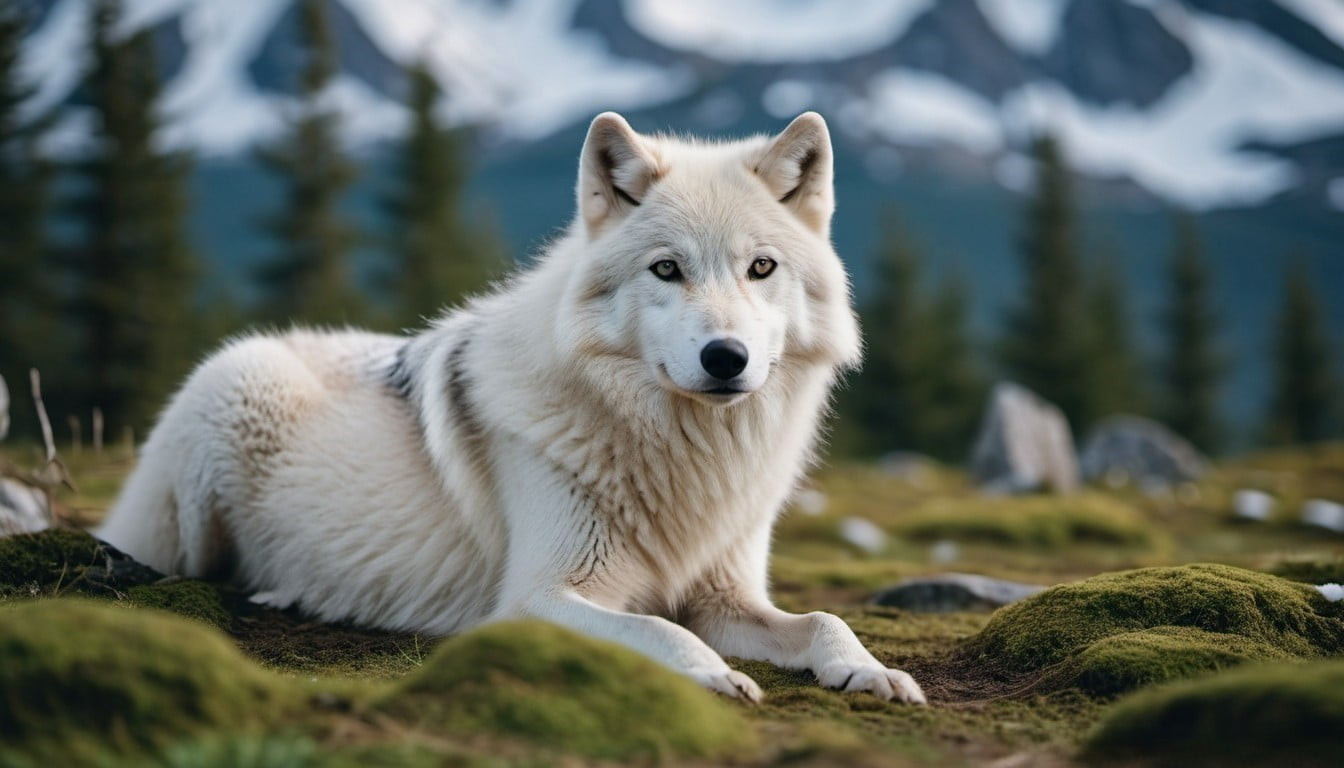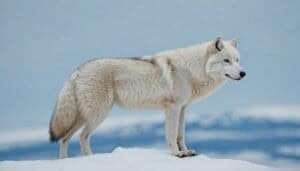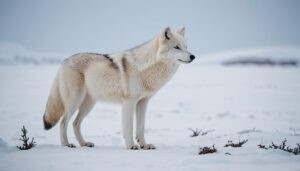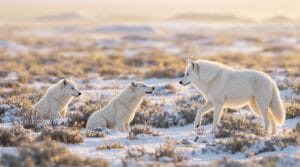Introduction
Arctic wolves thrive in one of the planet’s harshest environments, showcasing remarkable adaptability to the seasonal changes in their habitat
This article explores their physical and behavioral adaptations, dietary shifts, changes in fur and pack behavior, breeding habits, and the impact of climate change on their survival strategies. Join us as we delve into the fascinating world of Arctic wolves and their resilience in the face of nature’s extremes
Physical and Behavioral Adaptations
Arctic wolves have evolved various physical and behavioral adaptations to survive in the extreme conditions of the Arctic
These adaptations are crucial for maintaining their body heat, finding food, and ensuring the survival of the pack during the harsh winters and relatively milder summers
Thick Fur and Insulation
One of the most vital physical adaptations of Arctic wolves is their thick fur. Their double-layered coat consists of a dense, soft underfur and a longer, coarser outer layer
This combination provides excellent insulation against the frigid Arctic temperatures, which can drop as low as -30°F (-34°C). The outer layer repels water and snow, keeping the underfur dry and warm. This insulation is critical during the winter months when temperatures are at their lowest
Body Fat and Energy Storage
Arctic wolves also rely on body fat for insulation and energy storage
During the summer, when prey is more abundant, they consume more food to build up fat reserves. This extra fat not only provides additional insulation but also serves as an energy source during the winter when hunting can be more challenging. The ability to store energy helps them survive periods of food scarcity
Snow Navigation Techniques
Navigating through deep snow is another challenge Arctic wolves face. Their large, wide paws act like snowshoes, distributing their weight more evenly and preventing them from sinking into the snow
The fur on their paws also provides additional grip and insulation. These adaptations enable Arctic wolves to travel long distances in search of food and to follow migrating prey herds
Pack Dynamics and Hunting
Behaviorally, Arctic wolves adapt to the changing seasons by altering their pack dynamics and hunting strategies. In winter, packs may come together to hunt larger prey such as musk oxen and caribou
Cooperative hunting allows them to take down animals that would be too large for a single wolf to tackle. This teamwork is essential for securing enough food to sustain the pack during the colder months
Denning and Pup Rearing
In the warmer months, Arctic wolves focus on raising their young. They dig dens in the ground or use natural shelters to protect their pups from predators and harsh weather. During this time, the pack’s hunting efforts are directed toward providing food for the nursing mother and growing pups
The relatively mild summer conditions make it an ideal time for rearing young, as food is more readily available and the weather is less severe
Dietary Changes with Seasons
Arctic wolves adapt their diet to the changing availability of prey throughout the year. Seasonal variations in food sources require them to be flexible and resourceful in their hunting and foraging strategies
These dietary adaptations are crucial for their survival in the extreme and fluctuating Arctic environment
Winter Prey and Hunting Strategies
During the harsh winter months, Arctic wolves primarily hunt large prey such as musk oxen, caribou, and Arctic hares. These animals provide substantial amounts of meat and fat, essential for sustaining the wolves through the cold season
Hunting large prey often requires the coordinated efforts of the entire pack. Wolves use strategic group hunting techniques to isolate and take down these powerful animals. They utilize the pack’s strength in numbers to encircle and exhaust their prey before making the kill
Summer Diet and Foraging
In the summer, the Arctic landscape changes, and so does the diet of the Arctic wolf. With the thawing of snow and ice, smaller mammals, birds, and fish become more accessible. The wolves’ diet expands to include lemmings, ground squirrels, and migratory birds
Summer also brings a variety of vegetation, which, while not a primary food source, can be consumed for hydration and minor nutritional benefits. During this time, Arctic wolves may also scavenge on carcasses left by other predators or from animals that did not survive the winter
Hunting Techniques
Arctic wolves employ different hunting techniques depending on the season and the type of prey available. In winter, the pack collaborates closely, using their combined strength and strategic maneuvers to take down larger animals
They often track herds of caribou and musk oxen, patiently waiting for an opportunity to strike. In contrast, summer hunting tends to be more individualistic or involves smaller groups
Wolves may rely on stealth and speed to catch smaller, quicker prey. Their keen sense of smell and hearing also play a critical role in locating and capturing food
Food Caching and Storage
To cope with periods of food scarcity, Arctic wolves practice food caching. They bury excess food in the ground to store it for later consumption
This behavior is particularly important during the winter when hunting can be unpredictable, and prey may be scarce. By caching food, wolves create a reserve that they can rely on when immediate hunting is unsuccessful
This strategy ensures that they have a steady supply of nutrition even in the most challenging conditions
Seasonal Fur and Pack Behavior Changes
Arctic wolves undergo significant changes in their fur and pack behavior to adapt to the seasonal variations in their environment. These changes are essential for their survival, allowing them to maintain body temperature and social cohesion throughout the year
Winter Coat Growth
As winter approaches, Arctic wolves develop a thick, double-layered coat. The underfur is dense and woolly, providing excellent insulation, while the outer layer consists of longer guard hairs that repel water and snow
This adaptation helps them retain body heat during the frigid winter months when temperatures can plummet to extreme lows. The thick fur also provides camouflage against the snowy landscape, making it easier for them to hunt and avoid detection by predators
Shedding and Summer Coat
In the spring and early summer, Arctic wolves shed their winter coats. This process, known as molting, involves losing the dense underfur to make way for a lighter summer coat
The summer coat is shorter and less dense, helping the wolves stay cool during the warmer months. The lighter fur also reduces the risk of overheating while they engage in activities such as hunting and raising pups
This seasonal change in fur is crucial for regulating their body temperature and ensuring their comfort in varying climatic conditions
Cooperative Hunting in Winter
Pack behavior is especially important during the winter when the scarcity of prey requires cooperative hunting strategies. Arctic wolves form tight-knit packs, typically consisting of a dominant breeding pair and their offspring
These packs work together to hunt large prey, using coordinated tactics to corner and take down animals like caribou and musk oxen. Cooperative hunting increases their chances of a successful kill, ensuring that all members of the pack have access to the necessary food to survive the harsh winter
Social Structure in Different Seasons
The social structure of Arctic wolf packs can fluctuate with the seasons. During the breeding season in late winter and early spring, packs become more cohesive, focusing on the protection and nurturing of new pups
The alpha pair leads the pack, and other members contribute to the care and feeding of the young. In contrast, during the summer, packs may disperse slightly as food becomes more abundant, and individual members can hunt smaller prey independently
However, the pack still regroups regularly, maintaining social bonds and cooperation
Breeding Habits and Young Wolves’ Adaptation
Breeding and raising young wolves are critical periods that require significant adaptation for Arctic wolves. Their breeding habits and the way young wolves learn to survive in their harsh environment are vital to the species’ continuity
Mating Season and Timing
Arctic wolves have a specific breeding season that typically occurs in late winter, around February and March. This timing ensures that the pups are born in the spring, providing them with the best possible conditions for survival
The milder weather and increased availability of food during the spring and summer months are crucial for the growth and development of the pups. The alpha pair, usually the only breeding wolves in a pack, mates, and the female prepares for the arrival of her litter
Pup Birth and Early Life
The gestation period for Arctic wolves is about 63 days, with pups being born in late April to early May. A typical litter consists of 4 to 6 pups. The denning sites are carefully selected, often in sheltered locations such as caves or dug-out burrows, to protect the young from predators and harsh weather
For the first few weeks, the pups are entirely dependent on their mother for warmth and nutrition. The rest of the pack plays a vital role in supporting the mother by bringing food and protecting the den
Learning from the Pack
As the pups grow, they begin to emerge from the den and explore their surroundings. This period is crucial for learning survival skills. The pups observe and mimic the adults, learning how to hunt, navigate the terrain, and interact socially within the pack
Play behavior among the pups helps develop their physical abilities and social bonds. The pack environment provides a safe learning space where the young wolves can develop the necessary skills for adulthood
Survival Skills Development
The first year of life is critical for young Arctic wolves. By fall, the pups must have developed sufficient skills to contribute to the pack’s hunting efforts and survive the coming winter
They learn to cooperate during hunts, follow the pack’s lead, and understand the pack’s hierarchy. Older wolves mentor the young, teaching them effective hunting techniques and survival strategies. This education ensures that the young wolves are well-prepared to face the challenges of the Arctic environment
Threats and Impact of Climate Change
Arctic wolves face numerous threats that vary with the seasons, including predation, competition, and environmental challenges. Additionally, climate change poses a significant risk by altering their habitat and prey availability, further complicating their survival
Predators and Competitors
While Arctic wolves are apex predators, they still face threats from other predators and competitors. During the summer, when food sources are more abundant, competition with other carnivores such as polar bears and wolverines can be intense
These animals compete for similar prey, which can lead to conflicts and reduced food availability for the wolves. In winter, the scarcity of food increases competition within the wolf pack and with other predator species, sometimes leading to aggressive encounters
Environmental Challenges
The extreme Arctic environment presents constant challenges for Arctic wolves. In winter, they must contend with sub-zero temperatures, blizzards, and deep snow, all of which make hunting and traveling more difficult
The long periods of darkness can also impact their ability to hunt. In the summer, while temperatures are milder, the wolves must deal with melting ice and thawing ground, which can make denning sites unstable and affect their hunting grounds
Changes in Prey Availability
Climate change is significantly impacting the availability of prey for Arctic wolves. Warmer temperatures and changing precipitation patterns affect the migration and population sizes of key prey species like caribou and musk oxen
For example, delayed snowfalls and earlier thaws can disrupt the timing of migrations, making it harder for wolves to track and hunt their prey. Additionally, changing plant growth patterns affect the food sources for herbivores, indirectly impacting the wolves’ food supply
Habitat Alterations
Climate change is also causing profound changes in the Arctic habitat. Melting ice and permafrost, rising sea levels, and increasing temperatures are altering the landscape. These changes can lead to the loss of traditional denning sites and hunting grounds
As the Arctic environment transforms, wolves may be forced to travel greater distances to find suitable habitats and prey, which can increase the energy expenditure and risks associated with long migrations
Habitat fragmentation and the encroachment of human activities further exacerbate these challenges
Conclusion
Arctic wolves are remarkable creatures that have developed a wide range of adaptations to survive the extreme conditions of their environment
Their thick fur and efficient insulation protect them from the severe cold, while their dietary flexibility allows them to adjust to seasonal prey availability. Behavioral adaptations, such as cooperative hunting and pack dynamics, play a critical role in their survival strategy
The breeding habits and early life training ensure that young wolves develop the necessary skills to thrive. However, these adaptations are increasingly challenged by climate change, which disrupts their habitat and prey dynamics
Understanding these adaptations and the threats they face highlights the resilience of Arctic wolves and the need for conservation efforts to ensure their continued survival in a rapidly changing world











